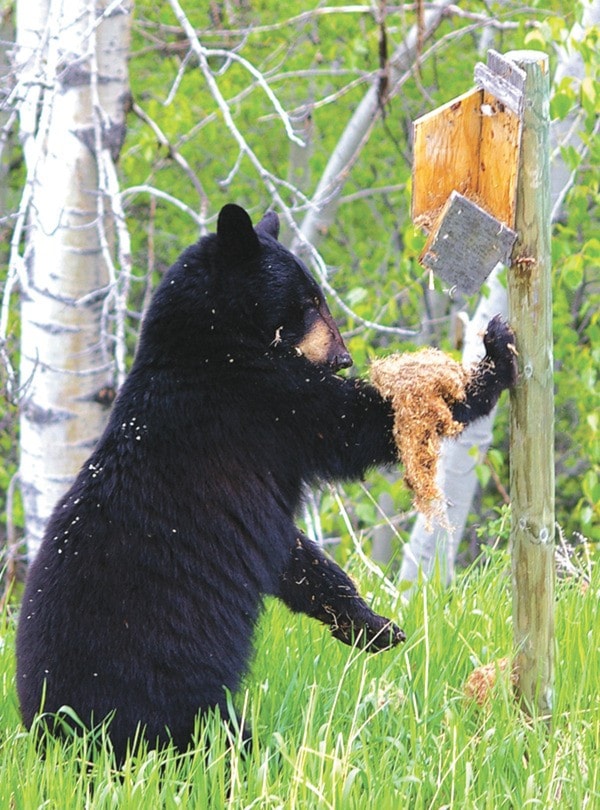According to WildSafeBC, the third week of September is when calls to Conservation Officers with bear complaints usually peak.
The first big frost is behind us, fruit trees are fully ripe and the bears are instinctively seeking to fatten up prior to hibernation.
There have been black bear sightings aplenty in Kimberley and Cranbrook, including near elementary schools in both communities.
According to wildsafebc.com, a general approach to reducing wildlife conflicts where you live is to go over in your mind:
1. Is there something that is bringing the wildlife into my living space?
a. Is it food – can I remove the food or can I make it inaccessible (as with the installation of a fence – electric or otherwise)?
b. Is it shelter – does my landscaping provide cover for the animal? Can the landscaping be altered to minimize the benefit to the wildlife?
c. Are they after my livestock or pets – is there another way I can manage these to minimize their exposure to predation?
2. Is the wildlife just passing through?
a. Maybe your yard is in the path or a travel route for bears – is there opportunity to accommodate the well-behaved traveller or is fencing needed?
b. Remember not all wildlife that passes through your living space is necessarily a problem.
3. Is there something that is forcing the wildlife into my area?
a. Usually external factors such as disturbance to existing habitats are beyond an individual’s ability to deal with but you can approach local officials to see what they can do.
b. Maybe it is a temporary phenomenon such as a drought or severe winter – Are there strategies that you can employ that will allow the wildlife to survive but not become habituated or food-conditioned in your area?
4. Is the wildlife in my living space just a feature or is it a ‘problem’ or could it become a problem? Understanding of how wildlife can shift from being something nice to see or experience to something that is a real threat to human safety and/or property is not always easy. Hindsight usually lets us see when the wildlife became a problem but by then it is often too late. Your best strategy is to think about what the long term outcomes could be from your present interactions with wildlife.
WildSafeBC stresses the importance of keeping bears moving through the community rather than stopping to feed on human attractants.
The major attractant to black bears garbage — in fact the cause of 50 per cent of the calls to the COS regarding black bears, when an attractant was noted, was garbage for the period of 2010-2013, says wildsafebc.com
Some tips for dealing with your household garbage:
Store garbage in a secure building until collection day or consider purchasing a bear-resistant household container.
Ensure bins are tightly closed.
Regularly wash all recycling items and clean the bins that contain garbage or recycling.
Do not leave garbage in the back of a truck, even if it has a canopy.
If you cannot store garbage securely, freeze smelly items and add to the bin only on the morning of collection.
Next up are fruit trees, also a major bear attractant.
Pick fruit and allow it to ripen indoors or pick daily as it ripens. Do not allow windfall to accumulate on the ground.
If you do not want the fruit, prune the tree vigorously to prevent blossoms or spray spring blossoms with a garden hose to knock them off.
If you would like to make the fruit available to others, contact a local fruit exchange program or food bank.
Consider using electric fencing to protect your fruit trees.
If you no longer want to manage your tree, consider replacement with a native, non-fruit bearing variety.
Please note that birdseed is a very good source of calories for bears and other wildlife. A kilogram of sunflower seeds has approximately 8,000 calories – about 20 times the caloric reward a bear would get from grazing the same weight of wild clover.
Use bird feeders only in the winter when bears are hibernating and natural bird food is limited.
If you feed birds in bear season, consider the following steps to minimize your contribution to human-bear conflicts:
Take bird feeders in at night
Keep the ground underneath the feeders clean and free of bird seed
Fill your feeders regularly with just a small amount of feed - this will decrease the reward a bear would receive if it does get to your feeder.
Pets and pet food
Feed pets indoors.
If pets are fed outside, ensure all food is cleaned up.
Store pet food in a secure location or in a bear-resistant bin.
Barbeques
Clean barbeques after use by burning off the grill entirely.
Remove and clean the grease trap after every use.
Cover and/or store indoors (do not take propane tank indoors).
Using common sense all year round, but especially right now, when bears are active in town, can help you avoid human wildlife conflict and save a bear’s life.
